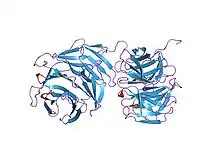| NHL repeat | |||||||||||
|---|---|---|---|---|---|---|---|---|---|---|---|
 Structure of the brain tumor-Pumilio translation repressor complex.[1] | |||||||||||
| Identifiers | |||||||||||
| Symbol | NHL | ||||||||||
| Pfam | PF01436 | ||||||||||
| Pfam clan | CL0186 | ||||||||||
| InterPro | IPR001258 | ||||||||||
| SCOP2 | 1q7f / SCOPe / SUPFAM | ||||||||||
| CDD | cd05819 | ||||||||||
| |||||||||||
The NHL repeat, named after ncl-1, HT2A and lin-41, is an amino acid sequence found largely in a large number of eukaryotic and prokaryotic proteins. For example, the repeat is found in a variety of enzymes of the copper type II, ascorbate-dependent monooxygenase family which catalyse the C-terminus alpha-amidation of biological peptides.[2] In many it occurs in tandem arrays, for example in the RING finger beta-box, coiled-coil (RBCC) eukaryotic growth regulators.[3] The arthropod 'Brain Tumor' protein (Brat; Q8MQJ9) is one such growth regulator that contains a 6-bladed NHL-repeat beta-propeller.[1][4]
The NHL repeats are also found in serine/threonine protein kinase (STPK) in diverse range of pathogenic bacteria. These STPK are transmembrane receptors with an intracellular N-terminal kinase domain and extracellular C-terminal sensor domain. In the STPK, PknD, from Mycobacterium tuberculosis, the sensor domain forms a rigid, six-bladed b-propeller composed of NHL repeats with a flexible tether to the transmembrane domain.
The NHL repeat has also been used to design a family of fully symmetrical 6-blade beta-propeller proteins called "Pizza".[5] These proteins can also be engineered to bind mineral nanocrystals.[6]
References
- 1 2 Edwards TA, Wilkinson BD, Wharton RP, Aggarwal AK (October 2003). "Model of the brain tumor-Pumilio translation repressor complex". Genes Dev. 17 (20): 2508–2513. doi:10.1101/gad.1119403. PMC 218144. PMID 14561773.
- ↑ Kano S, Miyajima N, Fukuda S, Hatakeyama S (July 2008). "Tripartite motif protein 32 facilitates cell growth and migration via degradation of Abl-interactor 2". Cancer Res. 68 (14): 5572–5580. doi:10.1158/0008-5472.CAN-07-6231. PMID 18632609.
- ↑ Slack FJ, Ruvkun G (December 1998). "A novel repeat domain that is often associated with RING finger and B-box motifs". Trends Biochem. Sci. 23 (12): 474–5. doi:10.1016/S0968-0004(98)01299-7. PMID 9868369.
- ↑ Edwards TA, Pyle SE, Wharton RP, Aggarwal AK (April 2001). "Structure of Pumilio reveals similarity between RNA and peptide binding motifs". Cell. 105 (2): 281–9. doi:10.1016/S0092-8674(01)00318-X. PMID 11336677. S2CID 9341061.
- ↑ Tame, Jeremy R. H.; Zhang, Kam Y. J.; Park, Sam-Yong; Unzai, Satoru; Terada, Daiki; Simoncini, David; Addy, Christine; Noguchi, Hiroki; Voet, Arnout R. D. (21 October 2014). "Computational design of a self-assembling symmetrical β-propeller protein". Proceedings of the National Academy of Sciences. 111 (42): 15102–15107. Bibcode:2014PNAS..11115102V. doi:10.1073/pnas.1412768111. ISSN 0027-8424. PMC 4210308. PMID 25288768.
- ↑ Voet, AR; Noguchi, H; Addy, C; Zhang, KY; Tame, JR (17 August 2015). "Biomineralization of a Cadmium Chloride Nanocrystal by a Designed Symmetrical Protein". Angewandte Chemie International Edition. 54 (34): 9857–60. doi:10.1002/anie.201503575. PMID 26136355.